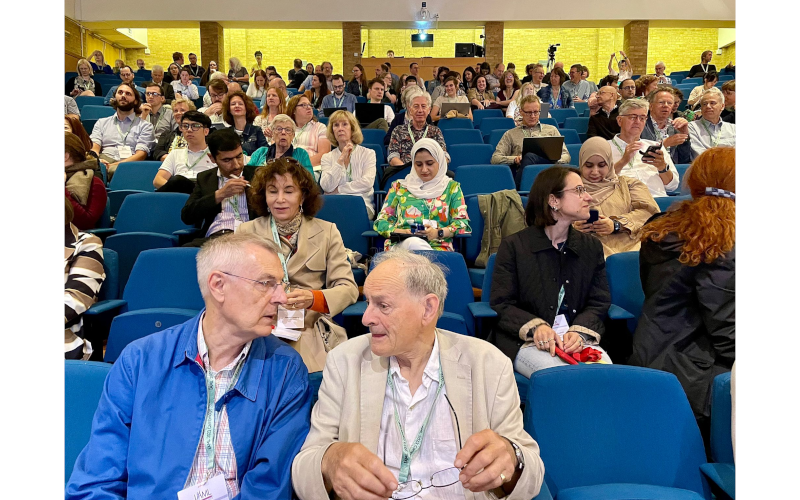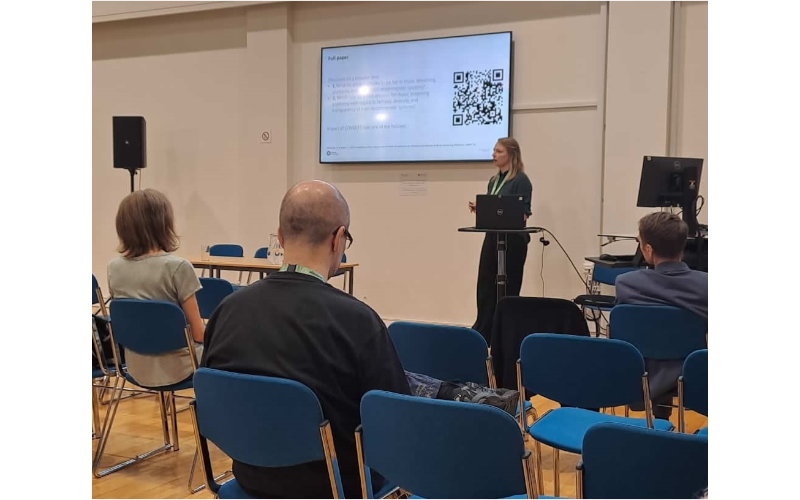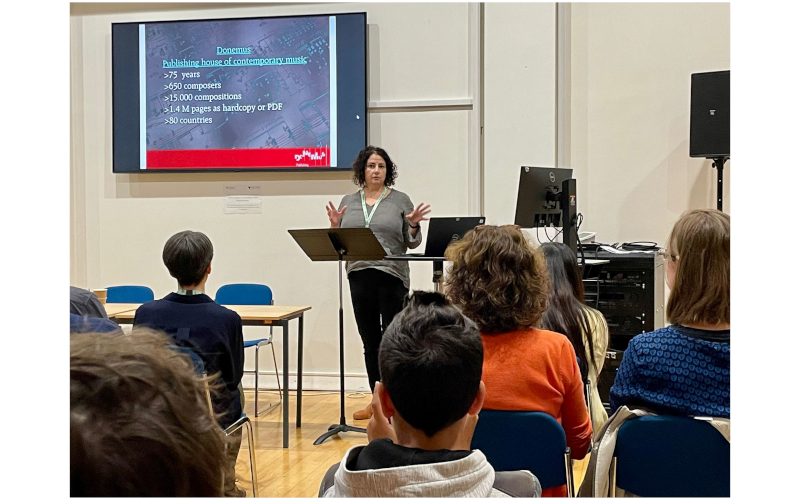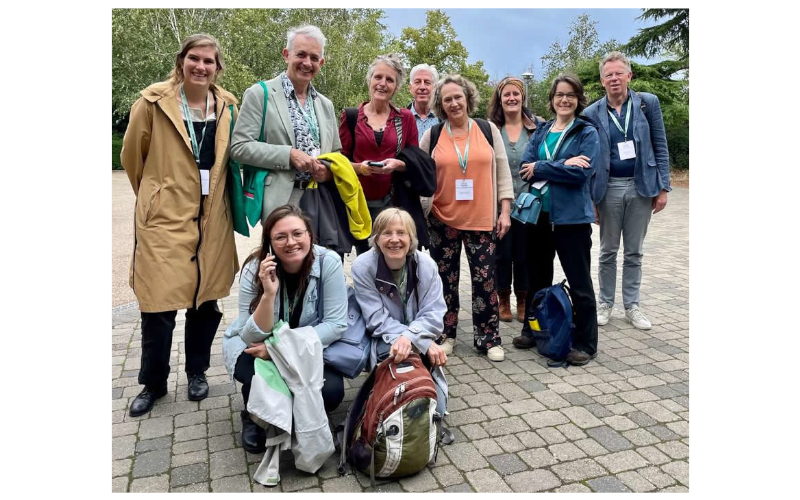The following is by Eric van Balkum (Muziekschatten/Podiumkunst.net) and was originally published on the NVMB (IAML Netherlands) website. It is reprinted here with kind permission. English follows.
Van 30 juli tot 5 augustus vond weer het jaarlijkse IAML-congres plaats, ditmaal in Cambridge in het Verenigd Koninkrijk. Ruim 300 professionals uit de muziekbibliotheek- en -archiefwereld verzamelden zich in de traditierijke universiteitsstad voor een week vol nieuwe inzichten, inspiratie, kennisdeling, cultuur snuiven, verbinding en verbroedering. De Nederlandstalige delegatie (Nederland en Vlaanderen) bestond uit een kleine 20 congresgangers, van wie de meerderheid heel de week bleef.
Zo’n conferentieweek kent een inmiddels uitgekristalliseerde indeling: een openingsceremonie op de zondagavond (natuurlijk met muziek), vijf conferentiedagen met twee plenaire ledenvergaderingen, een excursieprogramma op woensdagmiddag, concerten op (enkele) doordeweekse avonden en een afscheidsdiner op vrijdagavond (met muziek). De IAML-bestuurders en vertegenwoordigers van de nationale takken komen vaak voor en na conferentie vergaderend bijeen. Er is een apart programma voor begeleidende personen van congresgangers en vaak wordt ook nog een post-congress tour aangeboden. Bijzonder in het muzikale programma was dat het dit jaar voorzag in diverse wereldpremières, onder andere van Cecilia McDowalls A tree is a song, een speciaal voor de openingsavond geschreven koorwerk.
De eerste presentatie van een Nederlandse vertegenwoordiger was Eric van Balkums Uitvoeringsmedium: Creation of a multilingual vocabulary for performance media. Namens Podiumkunst.net deed hij kond van een recent gepubliceerde vocabulaire met meer dan 3000 geautoriseerde instrument-, stem- en ensemblebenamingen (in zes talen). Hiermee is het mogelijk eenduidige termen in collectiebeheersystemen te integreren en – via hun permanente iri’s - via linked data-systematiek diverse muzikale datasets met elkaar te verbinden. Een van de toepassingen maakt het mogelijk om repertoire voor specifieke bezettingen te vinden. Tijdens de Q&A-sessie toonden metadataspecialisten uit diverse landen interesse in de thesaurus.
In haar lezing Dutch music artists' outlook on strategy, creativity, and music streaming platform influence during and after the COVID-19 pandemic besprak Karlijn Dinnissen (Universiteit van Utrecht) de resultaten van een onderzoek naar hoe Nederlandse musici tijdens en na de coronaperiode met nieuwe digitale technieken zijn omgegaan.
Op donderdagochtend vertelde Aleksandra Markovic in haar lezing New technologies in service of old procedures: switching to digital rentals over de technologische veranderingen in de diensten die muziekuitgever Donemus haar klanten (en speciaal conservatoria en muziekbibliotheken) aanbiedt en de samenwerkingen met onlinedistributeurs als nkoda, Newzik en ASP.
Tijdens de Hot Topics-sessie op vrijdagmiddag presenteerden Jenny van Kampen en Pieter Goossen de ‘muzikale beslisboom’, een concreet, realistisch en integraal stuk gereedschap voor het saneren van bladmuziekcollecties in Nederlandse openbare bibliotheken. Items die afvloeien maar toch het bewaren waard zijn vinden een plek in het zogenoemde Muziekarsenaal. Het idee voor dit op nationaal niveau uitgewerkte plan ontstond tijdens de vorige IAML-conferentie in Praag.
NVMB-erelid (en penningmeester) Martie Severt ten slotte trad op als gastheer van de vrijdagochtendsessie rondom Middeleeuwse muziek. De nestor leidde het drietal sprekers in bij het publiek en regisseerde het vragengedeelte.
Sinds januari zijn Joris van Son en Harm Langenkamp werkzaam bij het Nederlands Muziek Instituut/Haags Gemeentearchief. Een toelage van de Société Gavignies stelt hen in staat de archieven van componisten en musici (beter) te ontsluiten. Muziekbibliothecaresse Paula Quint liet beide heren nader kennismaken met het vakgebied en hun (inter)nationale vakgenoten.
Reactie van Harm: Leuk om te ervaren dat het muziekbibliotheek en -archiefwezen in handen is van zo'n bevlogen, betrokken en hechte groep professionals! Never a dull moment (buiten het congres om)!
Joris: Helemaal mee eens! Daarnaast fascinerend om te zien hoe professionals wereldwijd bruggen slaan tussen de fysieke en de digitale wereld. Onder meer met grote digitaliseringsprojecten, 'linked open data', digitale leensystemen, 'born-digital archives' en online of hybride tentoonstellingen.
English translation:
From 30 July to 5 August, the annual IAML congress took place again, this time in Cambridge in the United Kingdom. More than 300 professionals from the music library and archive world gathered in the tradition-rich university city for a week full of new insights, inspiration, knowledge sharing, culture, connection and fraternization. The Dutch-speaking delegation (the Netherlands and Flanders) consisted of about 20 conference attendees, the majority of whom stayed all week.
Such a conference week has a now crystallized layout: an opening ceremony on Sunday evening (of course with music), five conference days with two plenary members' meetings, an excursion program on Wednesday afternoon, concerts on (some) weekday evenings and a farewell dinner on Friday evening (with music). The IAML directors and representatives of the national branches often meet before and after the conference. There is a separate program for accompanying people of conference attendees and often a post-congress tour is also offered. A special feature of the musical program was that this year it provided several world premieres, including Cecilia McDowall's A tree is a song, a choral work written especially for the opening night.
The first presentation by a Dutch representative was Eric van Balkum's Uitvoeringsmedium: Creation of a multilingual vocabulary for performance media. On behalf of Podiumkunst.net, he created a recently published vocabulary with more than 3,000 authorized instrument, voice and ensemble designations (in six languages). This makes it possible to integrate unambiguous terms into collection management systems and – via their permanent IRIs – to connect various musical datasets via linked data system. One of the applications makes it possible to find repertoire for specific line-ups. During the Q&A session, metadata specialists from various countries showed interest in the thesaurus.
In her lecture Dutch music artists' outlook on strategy, creativity, and music streaming platform influence during and after the COVID-19 pandemic, Karlijn Dinnissen (University of Utrecht) discussed the results of a study into how Dutch musicians have dealt with new digital techniques during and after the corona period.
On Thursday morning, Aleksandra Markovic gave a lecture entitled New technologies in service of old procedures: switching to digital rentals about the technological changes in the services that music publisher Donemus offers its customers (and especially conservatories and music libraries) and the collaborations with online distributors such as nkoda, Newzik and ASP.
During the Hot Topics session on Friday afternoon, Jenny van Kampen and Pieter Goossen presented the 'musical decision tree', a concrete, realistic and integral tool for the remediation of sheet music collections in Dutch public libraries. Items that are discarded but still worth keeping find a place in the so-called ‘muziekarsenaal’. The idea for this national plan arose at the previous IAML conference in Prague.
Finally, NVMB honorary member (and treasurer) Martie Severt hosted the Friday morning session on medieval music. The moderator introduced the trio of speakers to the audience and directed the question section.
Joris van Son and Harm Langenkamp have been working at the Netherlands Music Institute/The Hague Municipal Archives since January. A grant from the Société Gavigniès enables them to provide (better) access the composers' and musicians’ archives. Music librarian Paula Quint introduced both men to the discipline and their (inter)national colleagues.
Response from Harm: Nice to experience that the music library and archive system is in the hands of such an enthusiastic, committed and close-knit group of professionals! Never a dull moment (outside of congress)!
Joris: Totally agree! It is also fascinating to see how professionals worldwide build bridges between the physical and the digital world. This includes large digitisation projects, linked open data, digital loan systems, born digital archives and online or hybrid exhibitions.
- Facebook Like
- Share on Facebook
- Log in to post comments





